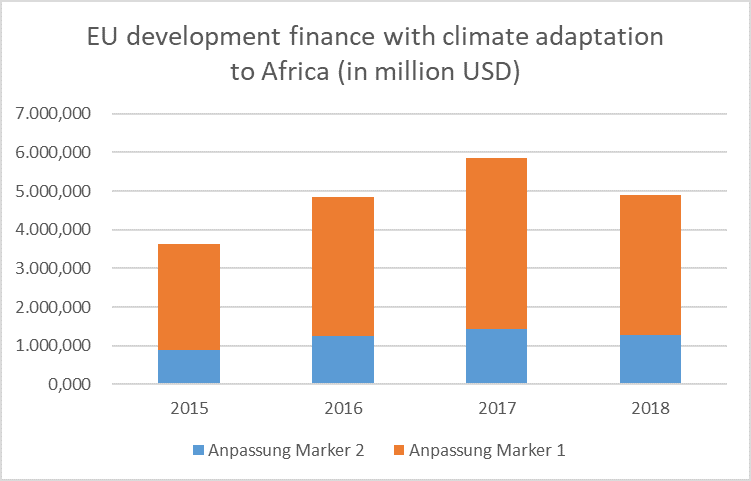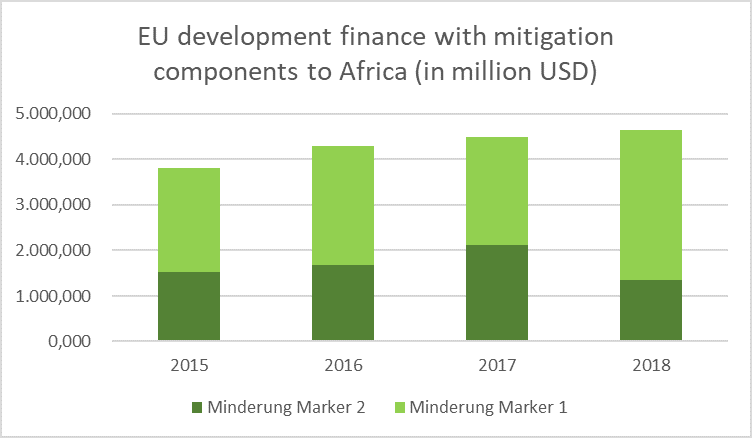International climate finance
EU presidency: what’s next in climate finance for Africa?
On July 1, 2020, Germany will take over the EU presidency for six months. This is the second time – after 2007 – that Chancellor Angela Merkel will be taking the chair. In a government statement on June 17, she presented key priorities for the EU presidency.
Climate protection in the German EU presidency
These include climate protection and the transition to a climate-neutral economy, where “consultations on European climate action legislation will be continued with great energy” and “the aim is to make a binding commitment to achieving climate neutrality in Europe by 2050, and to adjust the targets for 2030”. The statement calls for the EU to adopt a more ambitious nationally determined contribution (NDC) under the Paris Agreement in 2020. While the European Commission has so far only put forward proposals in the 50-55% CO2 reduction range, a proposal for a 65% reduction is pending in the European Parliament – a level of reduction that is also being demanded by many NGOs such as the Climate Action Network Europe (which also calls for climate neutrality as early as 2040). A new study by ClimAct, a think tank, underscores the feasibility of this more ambitious goal. Showing the world that the EU takes the 1.5°C limit of the Paris Agreement seriously is essential to Europe’s climate policy credibility in neighboring countries in Africa and elsewhere. This argument is also advanced by African NGOs in consultations on the EU presidency, for example.
Africa as a foreign policy focus
A second important topic of the German EU presidency is “more global responsibility for Europe”. According to Merkel, Africa will be a foreign-policy priority of the German EU presidency. This is also to be welcomed from a climate-policy perspective, since many people in Africa are severely impacted by the effects of climate change. It can be seen especially in the context of the COVID-19 crisis, where the consequences of the pandemic and the climate impacts reinforce each other. Not only drought, water shortages and floods in southern Africa, but also the locust crises in eastern Africa, have already been scientifically classified as compound risks in the coming months.
One of the worst knock-on effects of COVID-19 is expected to be a severe food crisis in developing countries, as noted by CARE in a briefing on COVID-19. There is an urgent need for action in this regard. National governments, donor governments and the international community must, above all, maintain support for climate-resilient agricultural livelihoods, for smallholders and female smallholders in particular, and continue to invest in combating hunger and malnutrition. Priority should be given to measures that can simultaneously create jobs and income for population groups that are particularly hard-hit by COVID-19. The climate-resilience and climate-protection priorities of the countries must be taken into account in accordance with their NDCs.
EU climate-relevant development finance for Africa: room to grow!
The EU as a whole is Africa’s most important climate finance donor. In particular, supranational EU institutions have increased their climate finance in recent years. In view of its major historical responsibility for the causes of climate change as well as its economic power, it is of course imperative that Europe plays a decisive role here. The evaluation of climate-relevant EU development finance for Africa based on the latest OECD figures shows that overall there was a significant increase between 2015 and 2017 (see Fig. 1, including the United Kingdom). In 2018, however, the numbers declined significantly, by almost USD 1 billion, to around the 2016 level. Projects that only pursue climate adaptation as a significant rather than a primary goal (marker 1) make up the lion’s share. Most of the funds go to sub-Saharan Africa (cumulated in all years about ten times as much as to Africa north of the Sahara). The decline in 2018 is particularly significant for “primary” adaptation projects (marker 2).

EU development finance for climate change adaptation in Africa. Source: own calculation based on OECD data
Even though the figures may differ fundamentally from year to year and the OECD figures do not fully match the climate finance officially reported to the UNFCCC every two years, such a significant decrease in funding in 2018 is an alarming signal, while at the same time climate change continues to progress dramatically. And these are not even additional funds specifically for adaptation, but “only” the total of the projects that also have an adaptation component. Application problems of the Rio markers, such as a significant overestimation of the adaptation dimension, have been discussed elsewhere.
“Africa’s Adaptation Gap Report 2” published in 2015 estimated at the time that the specific adaptation costs in Africa arising solely from global greenhouse gases emitted up to that point would amount to USD 7-15 billion per year in 2020. In 2030 to 2050, loss and damage incurred despite adaptation measures could amount to twice the adaptation costs.
In the area of mitigation – i.e. climate protection, for example through renewable energies or reducing deforestation – there has been a growth trend in recent years, but with much smaller increases (see Fig. 2). We cannot really speak of a clear growth path.

EU development finance for climate change mitigation in Africa. Source: own calculation based on OECD data
In any case, a greater expansion is needed. Many African countries are working on their new NDCs. Rwanda, for example, recently presented a revised and improved NDC, now for the first time with a relative emission-cutting target. As a neighboring continent, Europe should give greater support to the implementation of particularly ambitious NDCs.
The EU budget needs strong development and climate components
In addition to climate finance from the individual member states, a key milestone for EU development and climate finance during the German EU presidency will be the adoption of the EU’s multiannual financial framework (MFF) for 2021-2027. The new Neighbourhood, Development and International Cooperation Instrument (NDICI) will become the main vehicle for cooperation with developing countries. Overall, CARE supports the European Commission’s proposal for the 2021-2027 MFF and the Next Generation EU reconstruction fund. However, there is an urgent need to increase financial resources for measures outside the EU. In addition, the NDICI should be guided by a 50% target for climate and environmental spending to meet the European Green Deal and the Council agreement on COVID-19 to “build back better and greener”. As part of this effort, more should be invested in disaster risk reduction (DRR) at the local level in developing countries, which can also contribute significantly to climate adaptation. After all, preparing for a disaster and reducing its impact should be done before one occurs. This results in a much greater effectiveness (€1 for preparation saves €7 for the response). The MFF should also provide an urgently needed additional impetus to promote gender equality inside and outside the EU.
EU-Africa summit as a climate finance moment?
In recent years, the UN climate conference has often been a trigger for new financial pledges. That trigger will, of course, be missing this year because of the postponement of COP26. When doing their own homework – climate protection in the EU – European heads of state and government should agree on a much more ambitious climate protection target of a 65% CO2 reduction for 2030 at the EU summit on December 10-11 at the latest, which would be fitting for the 5th anniversary of the Paris Agreement on December 12. This would also send a strong signal to African partner countries that the EU is taking the 1.5°C target of the Paris Agreement seriously.
The EU-Africa summit – currently planned as a physical meeting in October, but not yet specifically scheduled – will be one of the development-policy highlights during the German EU presidency, at least according to the plans so far. German civil society is involved in the preparatory process, among other things through VENRO activities related to the presidency. The EU-Africa summit could gain in importance in terms of climate policy through a number of elements. Particularly ambitious, revised NDCs and also national adaptation plans (NAPs) of African countries should receive special appreciation and support here. The EU must put itself in a position to commit to further increases of climate finance for Africa, and African LDCs in particular, beyond 2020. It should also be studied where the implementation of genuine African initiatives such as the African Adaptation Initiative, the African Risk Capacity and the African Renewable Energy Initiative stand from the perspective of African actors, and what measures, if necessary, can be supported by Europe to overcome existing obstacles. The needs of the particularly affected sections of the population and access by civil society are central parameters in this regard. Questions of debt relief could also become more important in terms of climate policy.
Overall, the EU-Africa summit and the discussions about future partnership offer the EU opportunities to further expand its climate finance for Africa, despite or perhaps because of COVID-19, as a key element and second pillar of climate justice alongside its own climate protection efforts.
Sven Harmeling, CARE




